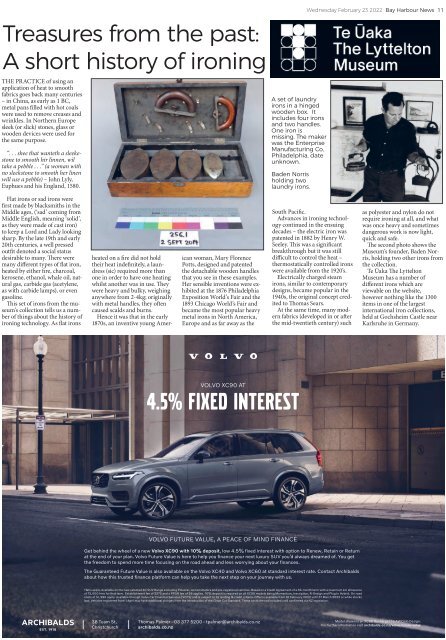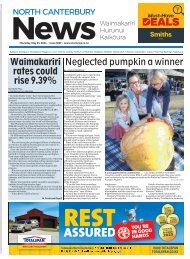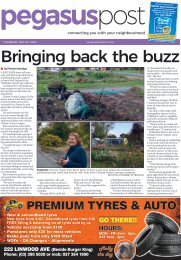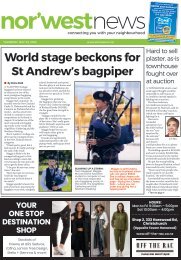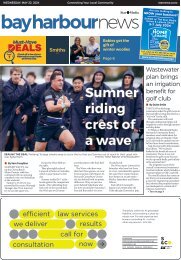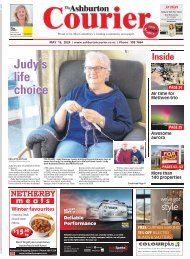Bay Harbour: February 23, 2022
Create successful ePaper yourself
Turn your PDF publications into a flip-book with our unique Google optimized e-Paper software.
Latest Canterbury news at starnews.co.nz<br />
Treasures from the past:<br />
A short history of ironing<br />
THE PRACTICE of using an<br />
application of heat to smooth<br />
fabrics goes back many centuries<br />
– in China, as early as 1 BC,<br />
metal pans filled with hot coals<br />
were used to remove creases and<br />
wrinkles. In Northern Europe<br />
sleek (or slick) stones, glass or<br />
wooden devices were used for<br />
the same purpose.<br />
“. . . shee that wanteth a sleekestone<br />
to smooth hir linnen, wil<br />
take a pebble . . .’’ (a woman with<br />
no sleekstone to smooth her linen<br />
will use a pebble) – John Lyly,<br />
Euphues and his England, 1580.<br />
A set of laundry<br />
irons in a hinged<br />
wooden box. It<br />
includes four irons<br />
and two handles.<br />
One iron is<br />
missing. The maker<br />
was the Enterprise<br />
Manufacturing Co,<br />
Philadelphia, date<br />
unknown.<br />
Baden Norris<br />
holding two<br />
laundry irons.<br />
Wednesday <strong>February</strong> <strong>23</strong> <strong>2022</strong> <strong>Bay</strong> <strong>Harbour</strong> News 11<br />
Flat irons or sad irons were<br />
first made by blacksmiths in the<br />
Middle ages, (‘sad’ coming from<br />
Middle English, meaning ‘solid’,<br />
as they were made of cast iron)<br />
to keep a Lord and Lady looking<br />
sharp. By the late 19th and early<br />
20th centuries, a well pressed<br />
outfit denoted a social status<br />
desirable to many. There were<br />
many different types of flat iron,<br />
heated by either fire, charcoal,<br />
kerosene, ethanol, whale oil, natural<br />
gas, carbide gas (acetylene,<br />
as with carbide lamps), or even<br />
gasoline.<br />
This set of irons from the museum’s<br />
collection tells us a number<br />
of things about the history of<br />
ironing technology. As flat irons<br />
heated on a fire did not hold<br />
their heat indefinitely, a laundress<br />
(sic) required more than<br />
one in order to have one heating<br />
whilst another was in use. They<br />
were heavy and bulky, weighing<br />
anywhere from 2-4kg; originally<br />
with metal handles, they often<br />
caused scalds and burns.<br />
Hence it was that in the early<br />
1870s, an inventive young American<br />
woman, Mary Florence<br />
Potts, designed and patented<br />
the detachable wooden handles<br />
that you see in these examples.<br />
Her sensible inventions were exhibited<br />
at the 1876 Philadelphia<br />
Exposition World’s Fair and the<br />
1893 Chicago World’s Fair and<br />
became the most popular heavy<br />
metal irons in North America,<br />
Europe and as far away as the<br />
South Pacific.<br />
Advances in ironing technology<br />
continued in the ensuing<br />
decades – the electric iron was<br />
patented in 1882 by Henry W.<br />
Seeley. This was a significant<br />
breakthrough but it was still<br />
difficult to control the heat –<br />
thermostatically controlled irons<br />
were available from the 1920’s.<br />
Electrically charged steam<br />
irons, similar to contemporary<br />
designs, became popular in the<br />
1940s, the original concept credited<br />
to Thomas Sears.<br />
At the same time, many modern<br />
fabrics (developed in or after<br />
the mid-twentieth century) such<br />
as polyester and nylon do not<br />
require ironing at all, and what<br />
was once heavy and sometimes<br />
dangerous work is now light,<br />
quick and safe.<br />
The second photo shows the<br />
Museum’s founder, Baden Norris,<br />
holding two other irons from<br />
the collection.<br />
Te Ūaka The Lyttelton<br />
Museum has a number of<br />
different irons which are<br />
viewable on the website,<br />
however nothing like the 1300<br />
items in one of the largest<br />
international iron collections,<br />
held at Gochsheim Castle near<br />
Karlsruhe in Germany.<br />
VOLVO XC90 AT<br />
4.5% FIXED INTEREST<br />
VOLVO FUTURE VALUE, A PEACE OF MIND FINANCE<br />
Get behind the wheel of a new Volvo XC90 with 10% deposit, low 4.5% fixed interest with option to Renew, Retain or Return<br />
at the end of your plan. Volvo Future Value is here to help you finance your next luxury SUV you’d always dreamed of. You get<br />
the freedom to spend more time focusing on the road ahead and less worrying about your finances.<br />
The Guaranteed Future Value is also available on the Volvo XC40 and Volvo XC60 at standard interest rate. Contact Archibalds<br />
about how this trusted finance platform can help you take the next step on your journey with us.<br />
T&Cs apply. Available on the new selected XC SUV Range excluding Polestar, demonstrators and pre-registered vehicles. Based on a Credit Agreement of a 36-month term with a maximum km allowance<br />
of 75,000 kms for that term. Establishment fee of $275 and a PPSR fee of $8 applies. 10% deposit is required on all XC90 models being Momentum, Inscription, R-Design and Plug In Hybrid. On road<br />
costs of $1,990 apply. Available through Volvo Car Financial Services (VCFS) and is subject to its lending & credit criteria. Offer is available from 16 <strong>February</strong> <strong>2022</strong> until 31 March <strong>2022</strong> or while stocks<br />
last. Vehicles registered from 1 April may have additional charges from the introduction of the Clean Car Standard. These costs are not included until confirmed via NZ legislation.<br />
38 Tuam St,<br />
Christchurch<br />
Thomas Palmer - 03 377 5200 - tpalmer@archibalds.co.nz<br />
archibalds.co.nz<br />
Model shown is an XC90 Recharge (T8 AWD) R-Design.<br />
For further information visit archibalds.co.nz/volvo-future-value


